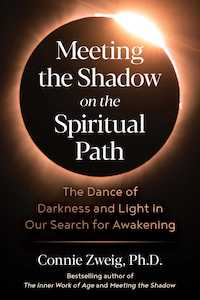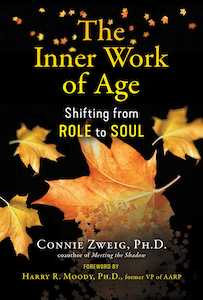
Meeting the Shadow on the Spiritual Path, by Connie Zweig, Ph.D.
Park Street Press, 9781644117224, 273 pages, May 2023
After reading a number of books on shadow work a few years ago, including one by Connie Zweig, I knew I wanted to read her latest book: Meeting the Shadow on the Spiritual Path. Zweig is a retired therapist, former book editor, and author of six other books, including The Inner Work of Age. She has been practicing and teaching meditation for more than 50 years. She is also an expert on ageism and has written extensively on the topic, as well as how mindfulness changes as people age. Zweig is also a wife, stepmother, and grandmother. Her website is https://conniezweig.com/.
Zweig began her spiritual journey at the age of 19 in a meditation class on the UC Berkeley campus and then decided to take a month-long meditation retreat. Following that retreat with teacher training and more meditation, Zweig later became disenchanted with the community and returned home. When she found a Jungian analyst, she began to learn about the shadow and started a ten-year journey to examine her own beliefs and the philosophies of mystical traditions. With her therapist’s help, she looked at her grief and disillusionment with her teacher and his teachings. She also studied, earned her Ph.D. and became a therapist.
Zweig does a deep dive into the shadow aspects of spiritual life and spiritual teachers, including research into almost every spiritual and religious tradition. I was shocked to hear of the widespread emotional and sexual abuse in all religious groups in the US and around the world. She discusses not only the widely publicized abuse in the Catholic church, but also in the Southern Baptist Church and others. She spoke with those who were abused, as well as some of the religious leaders themselves. She also discusses negative meditation experiences and some of the dangers of meditation, from “moderate anxiety to dissociation to psychotic symptoms that required hospitalization.”1
One of Zweig’s goals in writing this book is to provide information that fosters better discernment on the part of the student or parishioner:
“As would be the case with any abusive relationship, if they can detect a warning sign, such as emotional coercion or physical intimidation, they can more consciously choose to stay or leave, to speak up or stay silent. . . . If you are seeing a warning sign, please ask yourself: If I didn’t believe this teacher to be awakened or enlightened, would this behavior be called abusive?” 2
Zweig shares over and over that a student’s “longing for the light evokes its opposite: a shattering encounter with spiritual darkness.”3 This darkness is usually a projection of the person’s own darkness, usually formed in childhood. She shares an example of a man who joined a Pentecostal church and began to fast, live out of his car, and even purchased a billboard for the church. He did all of this at the urging of his pastor to win souls and give as much money as possible to the church ministry. After working with Zweig in therapy, the man came to see the shaming and emotional abuse from the pastor as similar to his own father’s abuse. By healing the shame and guilt, he was able to claim a more conscious relationship with himself and his own sovereignty.
Zweig writes in a very conversational style, as if you are sitting in a coffee shop or someone’s home discussing the spiritual journey. The information is related in a very factual way, with her sources clearly noted and she has carefully done her research. Underscoring the information is her love for meditation and how it has shaped her life. The reverence she shows for the traditions and philosophy of meditation and spiritual practice have fueled her search for the truth and a solution to this type of abuse.
Meeting the Shadow on the Spiritual Path will be enjoyed by the serious meditation student, teacher, or anyone who has an interest in the holiness of meditation and spiritual teachers. Therapists and those who are interested in more information on shadow work would also benefit from reading this book. However, this book would not be a good reference for the beginner student of shadow work.
Zweig Includes a very extensive table of contents, which makes it easy to go back and find different sections. She divides the book into two parts: “Before the Fall: A Guide for Faithful Believers” and “After the Fall: A Guide for Disillusioned Believers”. She also breaks down Part One into “a longing for God”, “a longing for the human beloved” and “a longing for the divine human”. This puts the book into the proper context and makes it easier to navigate.
In Appendix 1 she includes the ASI Code of Ethics and in Appendix 2 she includes the IMS Code of Ethics. This information denotes clear boundaries for both the Association for Spiritual Integrity (ASI) and the Insight Meditation Society (IMS). This work also includes an extensive bibliography and a complete index including many of the people named in each of the chapters.
In Zweig’s own words:
“To sum up, we may meet a teacher’s shadow, we may meet our own shadow, or we may suffer disillusionment with spiritual beliefs or practices. In any case, our dreams of transcendence and communion fade. . . . When the meeting with the Other occurs, the descent begins. It is this loss of innocence and descent to the underworld that initiates us into the mystery and complexity of the human shadow, especially as it is linked to divine life.”4

PJ Spur is an author, intuitive, spiritual mentor, astrologer, and hypnotist. She does tarot & oracle card readings, natal chart readings, grief coaching, and relationship healing. She also has hosted a weekly “Coffee & Cards” event with her Soul Compass Community for the past four years. Her book Navigating Grief with Grace is available on Amazon. Learn more at www.dearpj.com


